Chenhui Wang
UCLA Department of Statistics, Los Angeles, CA
Autoregressive Medical Image Segmentation via Next-Scale Mask Prediction
Feb 28, 2025Abstract:While deep learning has significantly advanced medical image segmentation, most existing methods still struggle with handling complex anatomical regions. Cascaded or deep supervision-based approaches attempt to address this challenge through multi-scale feature learning but fail to establish sufficient inter-scale dependencies, as each scale relies solely on the features of the immediate predecessor. To this end, we propose the AutoRegressive Segmentation framework via next-scale mask prediction, termed AR-Seg, which progressively predicts the next-scale mask by explicitly modeling dependencies across all previous scales within a unified architecture. AR-Seg introduces three innovations: (1) a multi-scale mask autoencoder that quantizes the mask into multi-scale token maps to capture hierarchical anatomical structures, (2) a next-scale autoregressive mechanism that progressively predicts next-scale masks to enable sufficient inter-scale dependencies, and (3) a consensus-aggregation strategy that combines multiple sampled results to generate a more accurate mask, further improving segmentation robustness. Extensive experimental results on two benchmark datasets with different modalities demonstrate that AR-Seg outperforms state-of-the-art methods while explicitly visualizing the intermediate coarse-to-fine segmentation process.
HiDiff: Hybrid Diffusion Framework for Medical Image Segmentation
Jul 03, 2024

Abstract:Medical image segmentation has been significantly advanced with the rapid development of deep learning (DL) techniques. Existing DL-based segmentation models are typically discriminative; i.e., they aim to learn a mapping from the input image to segmentation masks. However, these discriminative methods neglect the underlying data distribution and intrinsic class characteristics, suffering from unstable feature space. In this work, we propose to complement discriminative segmentation methods with the knowledge of underlying data distribution from generative models. To that end, we propose a novel hybrid diffusion framework for medical image segmentation, termed HiDiff, which can synergize the strengths of existing discriminative segmentation models and new generative diffusion models. HiDiff comprises two key components: discriminative segmentor and diffusion refiner. First, we utilize any conventional trained segmentation models as discriminative segmentor, which can provide a segmentation mask prior for diffusion refiner. Second, we propose a novel binary Bernoulli diffusion model (BBDM) as the diffusion refiner, which can effectively, efficiently, and interactively refine the segmentation mask by modeling the underlying data distribution. Third, we train the segmentor and BBDM in an alternate-collaborative manner to mutually boost each other. Extensive experimental results on abdomen organ, brain tumor, polyps, and retinal vessels segmentation datasets, covering four widely-used modalities, demonstrate the superior performance of HiDiff over existing medical segmentation algorithms, including the state-of-the-art transformer- and diffusion-based ones. In addition, HiDiff excels at segmenting small objects and generalizing to new datasets. Source codes are made available at https://github.com/takimailto/HiDiff.
FLDM-VTON: Faithful Latent Diffusion Model for Virtual Try-on
Apr 22, 2024Abstract:Despite their impressive generative performance, latent diffusion model-based virtual try-on (VTON) methods lack faithfulness to crucial details of the clothes, such as style, pattern, and text. To alleviate these issues caused by the diffusion stochastic nature and latent supervision, we propose a novel Faithful Latent Diffusion Model for VTON, termed FLDM-VTON. FLDM-VTON improves the conventional latent diffusion process in three major aspects. First, we propose incorporating warped clothes as both the starting point and local condition, supplying the model with faithful clothes priors. Second, we introduce a novel clothes flattening network to constrain generated try-on images, providing clothes-consistent faithful supervision. Third, we devise a clothes-posterior sampling for faithful inference, further enhancing the model performance over conventional clothes-agnostic Gaussian sampling. Extensive experimental results on the benchmark VITON-HD and Dress Code datasets demonstrate that our FLDM-VTON outperforms state-of-the-art baselines and is able to generate photo-realistic try-on images with faithful clothing details.
Low-dose CT Denoising with Language-engaged Dual-space Alignment
Mar 10, 2024Abstract:While various deep learning methods were proposed for low-dose computed tomography (CT) denoising, they often suffer from over-smoothing, blurring, and lack of explainability. To alleviate these issues, we propose a plug-and-play Language-Engaged Dual-space Alignment loss (LEDA) to optimize low-dose CT denoising models. Our idea is to leverage large language models (LLMs) to align denoised CT and normal dose CT images in both the continuous perceptual space and discrete semantic space, which is the first LLM-based scheme for low-dose CT denoising. LEDA involves two steps: the first is to pretrain an LLM-guided CT autoencoder, which can encode a CT image into continuous high-level features and quantize them into a token space to produce semantic tokens derived from the LLM's vocabulary; and the second is to minimize the discrepancy between the denoised CT images and normal dose CT in terms of both encoded high-level features and quantized token embeddings derived by the LLM-guided CT autoencoder. Extensive experimental results on two public LDCT denoising datasets demonstrate that our LEDA can enhance existing denoising models in terms of quantitative metrics and qualitative evaluation, and also provide explainability through language-level image understanding. Source code is available at https://github.com/hao1635/LEDA.
HOPE: Hybrid-granularity Ordinal Prototype Learning for Progression Prediction of Mild Cognitive Impairment
Jan 19, 2024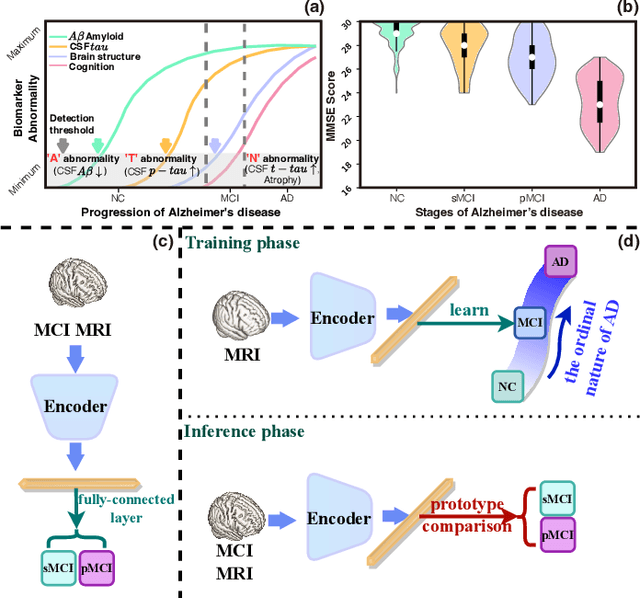
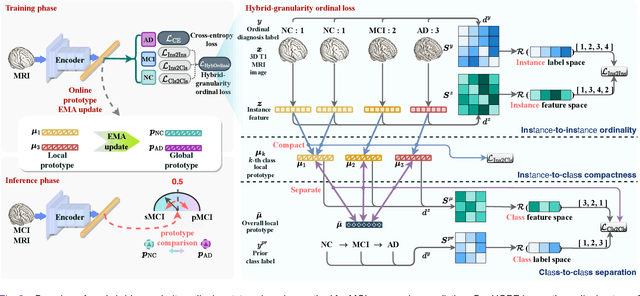
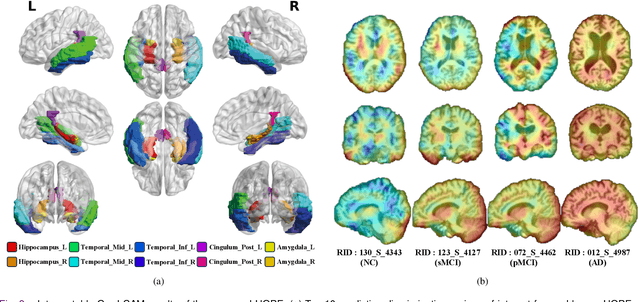

Abstract:Mild cognitive impairment (MCI) is often at high risk of progression to Alzheimer's disease (AD). Existing works to identify the progressive MCI (pMCI) typically require MCI subtype labels, pMCI vs. stable MCI (sMCI), determined by whether or not an MCI patient will progress to AD after a long follow-up. However, prospectively acquiring MCI subtype data is time-consuming and resource-intensive; the resultant small datasets could lead to severe overfitting and difficulty in extracting discriminative information. Inspired by that various longitudinal biomarkers and cognitive measurements present an ordinal pathway on AD progression, we propose a novel Hybrid-granularity Ordinal PrototypE learning (HOPE) method to characterize AD ordinal progression for MCI progression prediction. First, HOPE learns an ordinal metric space that enables progression prediction by prototype comparison. Second, HOPE leverages a novel hybrid-granularity ordinal loss to learn the ordinal nature of AD via effectively integrating instance-to-instance ordinality, instance-to-class compactness, and class-to-class separation. Third, to make the prototype learning more stable, HOPE employs an exponential moving average strategy to learn the global prototypes of NC and AD dynamically. Experimental results on the internal ADNI and the external NACC datasets demonstrate the superiority of the proposed HOPE over existing state-of-the-art methods as well as its interpretability. Source code is made available at https://github.com/thibault-wch/HOPE-for-mild-cognitive-impairment.
* IEEE Journal of Biomedical and Health Informatics, 2024
BerDiff: Conditional Bernoulli Diffusion Model for Medical Image Segmentation
Apr 10, 2023Abstract:Medical image segmentation is a challenging task with inherent ambiguity and high uncertainty, attributed to factors such as unclear tumor boundaries and multiple plausible annotations. The accuracy and diversity of segmentation masks are both crucial for providing valuable references to radiologists in clinical practice. While existing diffusion models have shown strong capacities in various visual generation tasks, it is still challenging to deal with discrete masks in segmentation. To achieve accurate and diverse medical image segmentation masks, we propose a novel conditional Bernoulli Diffusion model for medical image segmentation (BerDiff). Instead of using the Gaussian noise, we first propose to use the Bernoulli noise as the diffusion kernel to enhance the capacity of the diffusion model for binary segmentation tasks, resulting in more accurate segmentation masks. Second, by leveraging the stochastic nature of the diffusion model, our BerDiff randomly samples the initial Bernoulli noise and intermediate latent variables multiple times to produce a range of diverse segmentation masks, which can highlight salient regions of interest that can serve as valuable references for radiologists. In addition, our BerDiff can efficiently sample sub-sequences from the overall trajectory of the reverse diffusion, thereby speeding up the segmentation process. Extensive experimental results on two medical image segmentation datasets with different modalities demonstrate that our BerDiff outperforms other recently published state-of-the-art methods. Our results suggest diffusion models could serve as a strong backbone for medical image segmentation.
Sequential convolutional network for behavioral pattern extraction in gait recognition
Apr 23, 2021



Abstract:As a unique and promising biometric, video-based gait recognition has broad applications. The key step of this methodology is to learn the walking pattern of individuals, which, however, often suffers challenges to extract the behavioral feature from a sequence directly. Most existing methods just focus on either the appearance or the motion pattern. To overcome these limitations, we propose a sequential convolutional network (SCN) from a novel perspective, where spatiotemporal features can be learned by a basic convolutional backbone. In SCN, behavioral information extractors (BIE) are constructed to comprehend intermediate feature maps in time series through motion templates where the relationship between frames can be analyzed, thereby distilling the information of the walking pattern. Furthermore, a multi-frame aggregator in SCN performs feature integration on a sequence whose length is uncertain, via a mobile 3D convolutional layer. To demonstrate the effectiveness, experiments have been conducted on two popular public benchmarks, CASIA-B and OU-MVLP, and our approach is demonstrated superior performance, comparing with the state-of-art methods.
Computational efficient deep neural network with difference attention maps for facial action unit detection
Nov 27, 2020
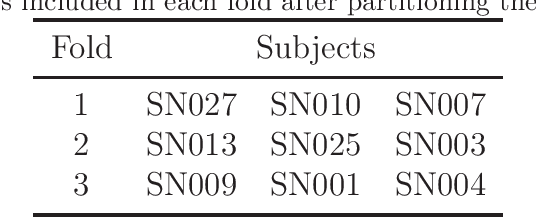


Abstract:In this paper, we propose a computational efficient end-to-end training deep neural network (CEDNN) model and spatial attention maps based on difference images. Firstly, the difference image is generated by image processing. Then five binary images of difference images are obtained using different thresholds, which are used as spatial attention maps. We use group convolution to reduce model complexity. Skip connection and $\text{1}\times \text{1}$ convolution are used to ensure good performance even if the network model is not deep. As an input, spatial attention map can be selectively fed into the input of each block. The feature maps tend to focus on the parts that are related to the target task better. In addition, we only need to adjust the parameters of classifier to train different numbers of AU. It can be easily extended to varying datasets without increasing too much computation. A large number of experimental results show that the proposed CEDNN is obviously better than the traditional deep learning method on DISFA+ and CK+ datasets. After adding spatial attention maps, the result is better than the most advanced AU detection method. At the same time, the scale of the network is small, the running speed is fast, and the requirement for experimental equipment is low.
HEU Emotion: A Large-scale Database for Multi-modal Emotion Recognition in the Wild
Jul 24, 2020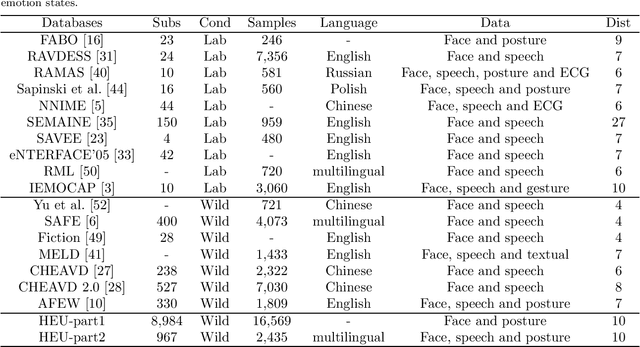
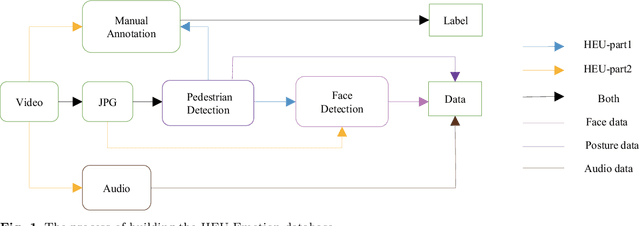
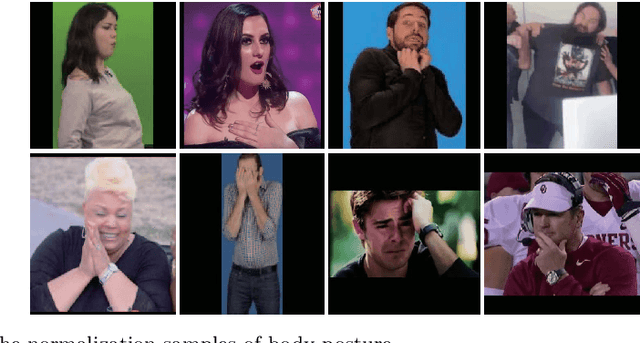

Abstract:The study of affective computing in the wild setting is underpinned by databases. Existing multimodal emotion databases in the real-world conditions are few and small, with a limited number of subjects and expressed in a single language. To meet this requirement, we collected, annotated, and prepared to release a new natural state video database (called HEU Emotion). HEU Emotion contains a total of 19,004 video clips, which is divided into two parts according to the data source. The first part contains videos downloaded from Tumblr, Google, and Giphy, including 10 emotions and two modalities (facial expression and body posture). The second part includes corpus taken manually from movies, TV series, and variety shows, consisting of 10 emotions and three modalities (facial expression, body posture, and emotional speech). HEU Emotion is by far the most extensive multi-modal emotional database with 9,951 subjects. In order to provide a benchmark for emotion recognition, we used many conventional machine learning and deep learning methods to evaluate HEU Emotion. We proposed a Multi-modal Attention module to fuse multi-modal features adaptively. After multi-modal fusion, the recognition accuracies for the two parts increased by 2.19% and 4.01% respectively over those of single-modal facial expression recognition.
 Add to Chrome
Add to Chrome Add to Firefox
Add to Firefox Add to Edge
Add to Edge